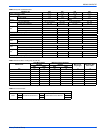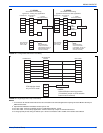
Subject to change without notice. Printed in U.S.A. 292043-UIM-B-0707
Copyright © by York International Corp. 2007. All rights reserved. Supersedes: 292043-UIM-A-0507
Unitary 5005 Norman
Product York OK
Group Drive 73069
DRAIN CONNECTIONS
All drain lines should be trapped a minimum of three inches, should be
pitched away from unit drain pan and should be no smaller than the coil
drain connection.
Route the drain line so that it does not interfere with accessibility to the
coil, air handling system or filter and will not be exposed to freezing
temperatures. See Figures 2, 3 and 4.
NOTE: When the coil is installed in an attic or above a finished ceiling,
an auxiliary drain pan should be provided under the coil as is specified
by most local building codes.
Coils should be installed level or pitched slightly toward the drain end.
Suggested pitch should not exceed 1/4 inch per foot of coil.
The coil is provided with a secondary drain that should be trapped and
piped to a location that will give the occupant a visual warning that the
primary drain is clogged. If the secondary drain is not used it must be
capped.
The drain pan connections are designed to ASTM Standard D 2466
Schedule 40. 3/4" PVC is preferred. Since the drains are not subject to
any pressure it is not necessary to use Schedule 40 pipe for drain lines.
It is recommended that all drain connections be sealed with teflon tape
or equivalent.
MAINTENANCE
Filters must be cleaned or replaced when they become dirty. Inspect at
least once per month. The frequency of cleaning depends upon the
hours of operation and the local atmospheric conditions. Clean filters
keep unit efficiency high.
COIL CLEANING
If the coil needs to be cleaned or replaced, it should be washed with
Calgon CalClean (mix one part CalClean to ten parts water). Allow solu-
tion to remain on coil for 30 minutes before rinsing with clean water.
Solution should not be permitted to come in contact with painted sur-
faces.
LUBRICATION
The bearings of the blower motor are permanently lubricated.
CONDENSATE DRAINS
During the cooling season check the condensate drain lines to be sure
that condensate is flowing from the primary drain but not from the sec-
ondary drain. If condensate ever flows from the secondary drain the unit
should be promptly shut off and the condensate pan and drains cleaned
to insure a free flowing primary drain.
Threaded drain connection should be hand-tightened, plus no
more than one turn.
Horizontal drain cutout in the center access panel should be
removed by using a utility knife. DO NOT TRY TO KNOCK OUT.
TROUBLESHOOTING GUIDE
PROBLEM POSSIBLE CAUSE
Blower Runs all of the time
1. No heat units do not have 6-pin connector installed.
2. Limit open or not connected.
3. Variable speed break-out tab broken out.
4. Blower OFF delay (approx. 1 min).
5. Thermostat fan switch in “ON” position.
Blown Fuse 1. Low voltage short to C or ground from R, Y, G, W, or O.
No 24V
1. 4-pin connector loose.
2. Loose wire from control to transformer (24V and 230V).
3. Blown fuse on control board.
No 2nd stage heat
1. Check 6-pin connector and connections to panel mount relays.
2. Verify that both W
1 & W2 are connected at the terminal strip.
No Heat or Limited Heating
1. Check filter.
2. Closed registers.
3. Restricted airflow (supply registers or return registers)
4. Check blower motor operation.
5. If the safety limit opens 4 times, the control will not permit the heating element to operate for 1 hour.


















